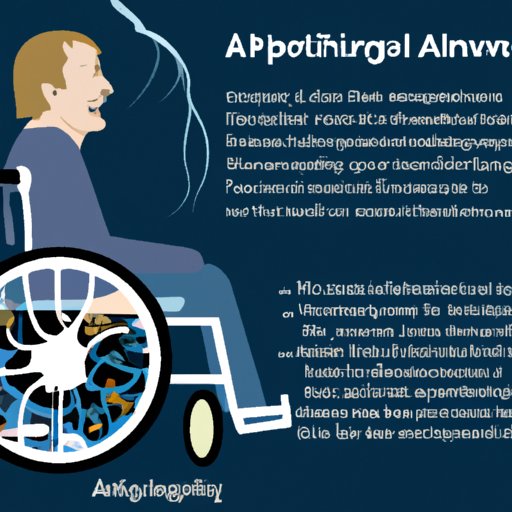
I. Introduction
Stephen Hawking was a renowned physicist known for his groundbreaking work on black holes, relativity, and cosmology. He was diagnosed with a debilitating disease at the age of 21, but despite his physical limitations, he continued to push the boundaries of scientific knowledge. In this article, we will explore Hawking’s remarkable life with ALS and what we can learn from his resilience and dedication to his work.
II. Stephen Hawking’s Life with ALS: A Journey of Resilience and Scientific Breakthroughs
Amyotrophic lateral sclerosis (ALS), also known as Lou Gehrig’s disease, is a progressive neurodegenerative disease that affects nerve cells in the brain and spinal cord. This leads to the gradual loss of muscle control, eventually making it difficult to speak, move, and even breathe.
Hawking began experiencing symptoms of ALS when he was in his early twenties, including slurred speech and difficulty walking. He was diagnosed with the disease at the age of 21 and given only a few years to live. At the time, there was no treatment or cure for the disease, and the prognosis was grim.
Despite this, Hawking refused to let his illness hold him back. He adapted to his physical limitations by using a wheelchair and a speech synthesizer to communicate, and he continued his scientific work with determination and passion.
Hawking made many groundbreaking contributions to the field of physics throughout his career, including his work on black holes, which revolutionized our understanding of the universe. He also developed a theory of cosmology that attempted to reconcile Einstein’s theory of relativity with quantum mechanics.
III. The Science Behind Stephen Hawking’s ALS Diagnosis and How He Pushed Through
ALS is diagnosed through a combination of clinical exams and tests such as electromyography (EMG) and nerve conduction studies. The disease progresses differently for each individual, but in general, it leads to the gradual loss of muscle control in the body.
Hawking’s ALS progressed at a slow rate, giving him more time to adjust to his physical limitations. He eventually lost the ability to speak, but he continued to communicate through his speech synthesizer. He also lost the ability to move his limbs, but he continued to work by controlling a cursor with his cheek muscle.
Hawking’s determination to continue his scientific work despite his physical limitations was a testament to his resilience and perseverance. He would spend hours a day working on mathematics and physics, using his computer and speech synthesizer to communicate his ideas.
IV. An In-Depth Look at Stephen Hawking’s Battle with Motor Neuron Disease
Motor neuron disease (MND) is a type of ALS that affects the neurons responsible for controlling muscle movement. There are several different types of MND, each with its own unique characteristics and progression.
Hawking’s case of MND was different from others in several ways. One of the most striking differences was the slow progression of his illness. Many individuals with MND experience a much more rapid decline in muscle control, often becoming completely paralyzed within a few years of diagnosis. Hawking, on the other hand, lived with the disease for over 50 years, an incredibly long period for someone with MND.
The physical and emotional toll of MND on Hawking was significant. He required around-the-clock care from nurses and caregivers, and he experienced bouts of depression and frustration at times. However, he was able to maintain his humor and positive outlook on life, which helped him cope with the challenges of his illness.
V. Stephen Hawking’s Influence on the ALS Community and Research Efforts
The ALS community is made up of individuals with ALS, their families, caregivers, and researchers working to find a cure for the disease. Hawking was a prominent advocate for ALS research and awareness, using his platform to raise funds and promote scientific progress.
Hawking’s life and work have also had a profound impact on others with ALS. He showed that it is possible to live a full and meaningful life despite a debilitating illness, inspiring others with his resilience and determination.
VI. The Legacy of Stephen Hawking: Living with a Debilitating Disease and Changing the World of Physics
Stephen Hawking’s legacy is one of resilience and scientific breakthroughs. He pushed the boundaries of our understanding of the universe despite facing a devastating disease, inspiring others with his passion and determination.
One of the most important lessons that can be learned from Hawking’s life is the power of perseverance. Despite being faced with seemingly insurmountable challenges, he never gave up on his dreams or his work. He showed that anything is possible if we have the courage and determination to persevere.
Conclusion: Reflection on What Hawking’s Life Can Teach Us and How We Can Apply This Knowledge to Our Own Lives
Stephen Hawking’s life with ALS was a testament to the power of resilience and perseverance. He showed that anything is possible, even in the face of great adversity.
As we reflect on his life and legacy, we can take inspiration from his determination and apply it to our own lives. Whether we are facing personal challenges or trying to make a difference in the world, we can look to Hawking as an example of what is possible when we refuse to give up.





